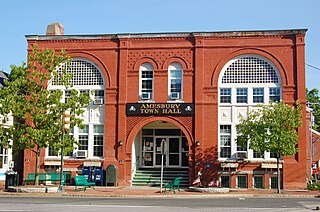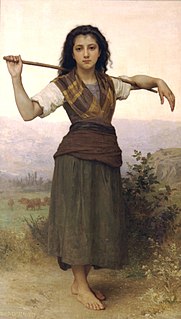
The John Greenleaf Whittier Homestead is the birthplace and home of American Quaker poet and abolitionist John Greenleaf Whittier. It currently serves as a museum. The homestead is located at 305 Whittier Road in Haverhill, Massachusetts.

The John Greenleaf Whittier Homestead is the birthplace and home of American Quaker poet and abolitionist John Greenleaf Whittier. It currently serves as a museum. The homestead is located at 305 Whittier Road in Haverhill, Massachusetts.

The home was built in 1688 by Thomas Whittier, pioneer and great-great-grandfather of John Greenleaf Whittier. [1] Thomas Whittier chose the site (originally 148 acres) for its proximity to Fernside Brook, which could both provide water and turn the wheel of a gristmill.
The future poet John Greenleaf Whittier was born in December 1807 [2] in the southwest parlor of the farm house, which today remains essentially the same as it was in that year. Growing up, Whittier lived the hard-working life of a farm boy. Amid strenuous labor, he suffered chronic headaches and fatigue and attended Quaker meetings or school infrequently. [2] He also learned he was color-blind when he was unable to differentiate between ripe and unripe strawberries. [3]
Here, he developed his love of reading thanks to a modest family library which included the poetry of Robert Burns. [2] It was Whittier's sister Elizabeth and his mother Abigail who particularly encouraged his literary interests as a boy. His father John, on the other hand, was more economy-minded and insisted that his son's farm duties were more important than education or writing. [4] Whittier's first poem, "The Exile's Departure", was published by the Newburyport Free Press on June 18, 1826, by editor William Lloyd Garrison. [5] Garrison helped young Whittier attend Haverhill Academy, tuition for which was paid with food grown at the family farm. [6] For a brief period, he was editor of the Haverhill Gazette. [7]
Whittier lived in the home for 29 years. He moved to Amesbury, Massachusetts in 1836 [8] and sold the family farm. The home he moved to, the John Greenleaf Whittier House, is also open to the public.
The homestead is the setting for Whittier's best-known narrative poem Snow-Bound , [9] published in 1866 and an instant bestseller. Whittier also set many of his other poems in the Haverhill area, including "Fernside Brook", "The Barefoot Boy", and "The Sycamores". [10] The popularity of Snow-Bound also made the home popular; revived interest in nostalgic kitchens spurred by the poem inspired fans to try to emulate Whittier's kitchen. The poet noted in 1881 that a Cleveland, Ohio resident asked for exact measurements of his Haverhill kitchen in order to recreate Whittier's childhood hearth. "I certainly never dreamed when writing 'Snow-Bound' ... that it could be worthy of a counterfeit presentation", he wrote. [11]

After Whittier's death in 1892, James Carleton bought the farm. Carleton, a boyhood friend of the poet and a former mayor of Haverhill, donated the property to the Haverhill Whittier Club. [8] It was officially opened in 1893, a year after the poet's death. Today, it functions as a hands-on museum dedicated to the poet's memory; visitors are allowed to sit in chairs actually used by the family, and the guest register sits on the desk built in 1786 for the poet's great grandfather.
The family burial plot is also located on the grounds of the Homestead. Whittier himself, however, is buried in Amesbury.
The home was opened as a museum during the Colonial Revival Movement in the United States and was among the first in an emerging trend of restoring homes of writers for tourism. [12] Books in this period by people like Alice Morse Earle particularly emphasized old-fashioned New England ways. Earle herself made an icon of Whittier's hearth by including a photo of it in her book Home Life in Colonial Days and frequently quoting Snow-Bound throughout her writings. [12]

Henry Wadsworth Longfellow was an American poet and educator whose works include "Paul Revere's Ride", The Song of Hiawatha, and Evangeline. He was the first American to translate Dante Alighieri's Divine Comedy and was one of the Fireside Poets from New England.

Amesbury is a city in Essex County, Massachusetts, located on the left bank of the Merrimack River near its mouth, upstream from Salisbury and across the river from Newburyport and West Newbury. The population was 16,283 at the 2010 census. A former farming and mill town, Amesbury is today largely residential. It is one of the two northernmost towns in Massachusetts.

Alice Cary was an American poet, and the older sister of fellow poet Phoebe Cary (1824–1871).

John Greenleaf Whittier was an American Quaker poet and advocate of the abolition of slavery in the United States. Frequently listed as one of the fireside poets, he was influenced by the Scottish poet Robert Burns. Whittier is remembered particularly for his anti-slavery writings, as well as his 1866 book Snow-Bound.

An idyll or idyl is a short poem, descriptive of rustic life, written in the style of Theocritus' short pastoral poems, the Idylls.

John Pierpont was an American poet, who was also successively a teacher, lawyer, merchant, and Unitarian minister. His most famous poem is The Airs of Palestine.

Phoebe Cary was an American poetess, and the younger sister of poetess Alice Cary (1820–1871). The sisters co-published poems in 1849, and then each went on to publish volumes of their own. After their deaths in 1871, joint anthologies of the sisters' unpublished poems were also compiled.

The John Greenleaf Whittier Home is a historic house located at 86 Friend Street, Amesbury, Massachusetts. It was the home of American poet and abolitionist John Greenleaf Whittier from 1836 until his death in 1892, and is now a nonprofit museum open to the public May 1 through October 31; an admission fee is charged. It was designated a National Historic Landmark in 1962, and listed on the National Register of Historic Places in 1966.

The Amesbury Friends Meetinghouse is a Friends Meeting House at 120 Friend Street in Amesbury, Massachusetts. Built in 1850 under the guidance of John Greenleaf Whittier, it is home to one of the leading Quaker congregations of the region, and historically hosted quarterly meetings for Quakers from across eastern Massachusetts and southeastern New Hampshire. The meetinghouse was listed on the National Register of Historic Places in 2002.

The Macy–Colby House is a historically significant saltbox house at 257 Main Street in Amesbury, Massachusetts. It is a historic house museum and has been listed on the National Register of Historic Places since 2008. In addition to its great age, it is notable for its association with Thomas Macy, an early settler of Nantucket and the subject of a poem by John Greenleaf Whittier, and for its long association with the locally significant Colby family.
Whittier Regional Vocational Technical High School, also known as “Whittier Tech” and/or “Big Whittier,” was founded in 1972. Located in the city of Haverhill, MA, United States, the school currently serves about 1400 students, with a 12:1 student-teacher ratio. It serves many surrounding cities and towns primarily in the northern section of Essex County, accepting students from Haverhill, Newburyport, Newbury, West Newbury, Rowley, Amesbury, Merrimac, Georgetown, Groveland, Ipswich, Salisbury, Lawrence and Methuen. The school was named in honor of local resident, Quaker poet, and slavery abolitionist John Greenleaf Whittier. Alongside this school, there is also a middle school called “J. G. Whittier Middle School” located in haverhill also named after the poet.

Claudia Emerson was an American poet. She won the 2006 Pulitzer Prize for her poetry collection Late Wife, and was named the Poet Laureate of Virginia by Governor Tim Kaine in 2008.

Edward Coote Pinkney was an American poet, lawyer, sailor, professor, and editor. Born in London in 1802, Pinkney made his way to Maryland. After attending college, he joined the United States Navy and traveled throughout the Mediterranean and elsewhere. He then attempted a law career but was unsuccessful and attempted to join the Mexican army, though he never did. He died at the age of 25 in 1828.
Nationality words link to articles with information on the nation's poetry or literature.
-- first stanza of Julia Ward Howe's Battle Hymn of the Republic conceived as both poem and lyrics to a popular tune and first published in February in The Atlantic Monthly

The Merrimack Valley is a bi-state region along the Merrimack River in the U.S. states of New Hampshire and Massachusetts. The Merrimack is one of the larger waterways in the New England region and has helped define the livelihood and culture of those living along it since native times.

Snow-Bound: A Winter Idyl is a long narrative poem by American poet John Greenleaf Whittier first published in 1866. The poem, presented as a series of stories told by a family amid a snowstorm, was extremely successful and popular in its time. The poem depicts a peaceful return to idealistic domesticity and rural life after the American Civil War.
Whittier House may refer to one of the following:

Elizabeth Hussey Whittier was an American poet and abolitionist, who founded the Female Anti-Slavery Society in Boston in 1833. Alongside her mother, she is credited with encouraging her brother John Greenleaf Whittier's interests in literature and poetry, and was his close companion and collaborator until her death.
| Wikimedia Commons has media related to John Greenleaf Whittier Homestead . |
Coordinates: 42°48′36.8″N71°2′15.6″W / 42.810222°N 71.037667°W